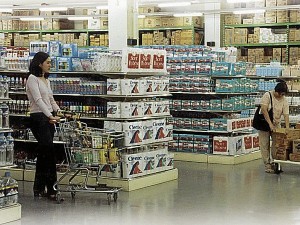
FILIPINOS, in general, make it a habit to prepare shopping lists, but are also less likely to stick to them.
Filipinos’ shopping habits are changing, especially when it comes to their regular trips to their favorite groceries.
This much was clear in the latest study released by international market research firm Nielsen, which found that Filipinos have been making more trips to the grocery, but buying less per trip.
At the same time, the agency’s annual Philippines Shopper Trends Report also found that Filipinos, in general, make it a habit to prepare shopping lists, but are also less likely to stick to them.
The report found that nine in 10 Filipino shoppers prepare a shopping list but most are not likely to stick to it.
Despite strict budgets and self-imposed shopping rules, almost seven in 10 shoppers do not stick to their shopping plans, meaning shoppers are still very open to impulse purchases.
“Manufacturers and retailers should be looking to implement store offers and promotions which connect with shoppers in order to generate increased sales,” Nielsen Philippines managing director Stuart Jamieson, says in a statement.
It also finds that Filipino shoppers have a high degree of loyalty toward both retailers and brands.
Only seven percent of Filipinos are likely to change the store they shop in based on promotional offerings and just nine percent regularly buy different brands due to promotions.
Nielsen’s Shopper Trends Report is an annual study of consumer shopping behavior that was conducted in urban locations nationwide. The study was fielded between October 8 and November 23, 2011, and interviewed at least 1,500 respondents aged 15-65 years old who were both main grocery buyers and key influencers.
The report also highlighted the changing dynamics of the shopping scene, possibly brought about by the growing number of groceries around the country, as well as the changing demographics and economic condition of the nation.
According to the study, Filipino shoppers are increasing the frequency with which they visit the grocery store, 45 percent shopping for groceries on a weekly basis, representing a 15-percentage point increase from last year.
The average frequency of grocery shopping trips increased to 2.6 visits per month in 2011, up from 2.2 in 2010.
“Following a high gross domestic product growth in 2010 due to the election, the Philippines economy slowed during 2011,” Jamieson says.
“The impact of the global economic crisis coupled with natural disasters both within and outside of the country caused consumers to be more cautious with their spending, and this is evidenced in the move to more frequent shopping visits but smaller basket sizes,” he adds.
Filipinos also increased the frequency of their top-up shopping from an average of once per month in 2010 to almost three times per month in 2011.
“Consumers are decreasing their basket size in order to manage their available cash, shopping only as the need arises,” he points out.
Within the stores, 30 percent of Filipino shoppers say they actively search for promotions when grocery shopping, while 40 percent say they only purchase items on promotion if it is a brand they like.
“This behavior illustrates Filipino shoppers’ loyalty to brands they have tried and tested, however, it also demonstrates price awareness when it comes to promotional engagement,” Jamieson says.
With rising awareness and visibility of environmental issues, nine in 10 Filipino shoppers claimed to make an effort to buy products that are friendly for the environment.
In reality, however, this effort does not always translate into actual purchases, with only 27 percent of shoppers saying that they purchase more or the same number of environmentally friendly products in 2011 compared to the previous year.
Some 44 percent of polled shoppers say they did not purchase any environmentally friendly products.
“Price remains a barrier for Filipinos to adopt environmentally friendly purchasing habits. Manufacturers must create cheaper alternatives in order to encourage shoppers to purchase environmentally friendly products.”